Have you heard about the term attribution? In digital marketing, it can be a real challenge.
Attribution is about connecting website events or sales with your marketing activities or channels. It’s a set of rules which define or credit a conversion or action to your marketing efforts. So it may sound simple in theory, but there’s more to it than meets the eye.
Why is digital attribution important?
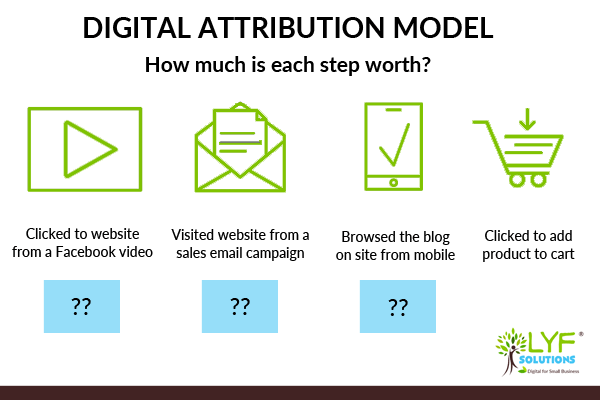
You develop offline marketing brochures, run paid social ads or have a website. However, do you know how these channels or your efforts lead to website events or sales? By attributing actions like conversions or leads to your activities, you can try to work out what’s working and what’s not. It could mean you will get a better grasp on your top messages or channels that are driving most leads or sales to your business. It can also expose wastage. That is less performing areas which could be like throwing cash outside the window. You wouldn’t throw your money into the sky, but you could be doing this if you are not across what channels are working for you.
The different types of attribution
Remember when we said attributing sales and conversions isn’t easy? Now let’s explore the common types of attribution models out there. These expose the flaws in attribution and what is and isn’t possible.
1. Last click attribution
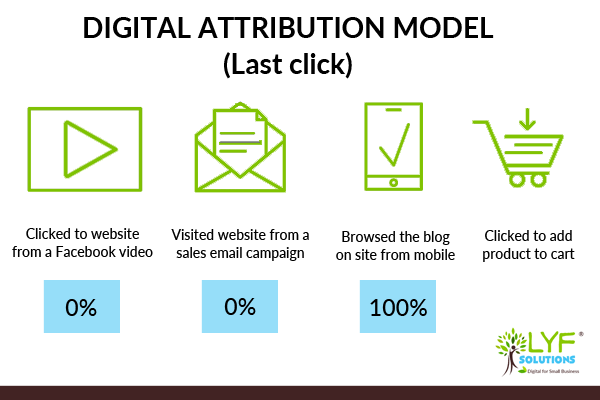
The default option for Google Analytics (last non-direct click) and many other platforms. It measures conversions by attributing 100% of the last channel the person was on before they acted.
That means, the person could have seen you via Facebook, but because they didn’t convert during that time, another channel such as organic search is the converter. That’s why many conversions are often tied to direct traffic also (someone types your site in their browser) or referral traffic (comes via another website) or via email. However, the exact pathway of sale or action was via several touchpoints.
Good: You can see quite quickly which channels lead to action at the end of your love sales funnel. So if the campaign objective were conversions, this would give you a clear indicator of which channel drove the revenue.
Bad: You can quickly change your budget or activities on a channel that may have assisted the person to convert in the first place. A typical example is a misconception around the ROI of social media channels, who often initiate a buyer in the funnel process, but don’t necessarily convert at the end overall. That isn’t because social media is a waste of money. It’s because it’s not the typical behaviour of users. This rule may not apply to everyone, but overall stats do say the average conversions rate is 1-2%.
2. First touch attribution
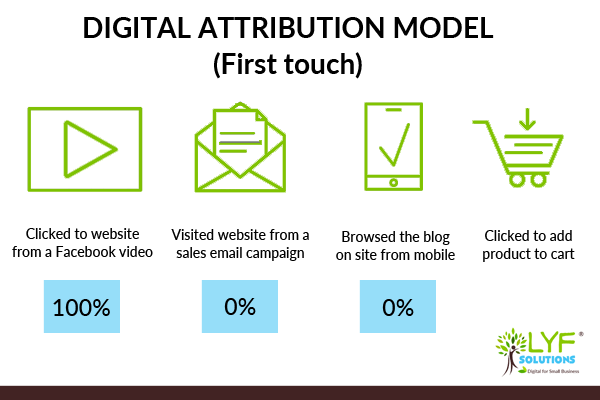
This model assigns 100% of the conversion credit to the first channel or destination the user arrived. The first touch may be misleading though – especially when you consider different devices people may use to interact with you, can be treated as separate people.
Commonly first touch attribution is used by businesses that value brand awareness or reach. That’s campaign goals where they want to know where people found out about them.
Good: You can find out what channels drive a great deal of brand awareness or how people found out about you overall.
Bad: This doesn’t consider the impact of other marketing such as campaigns. Also, users tend to take a long time to make a buying decision dependent on the product or the value of the purchase. Using this alone can make it difficult to assign a monetary value to conversion activities.
3. Linear attribution
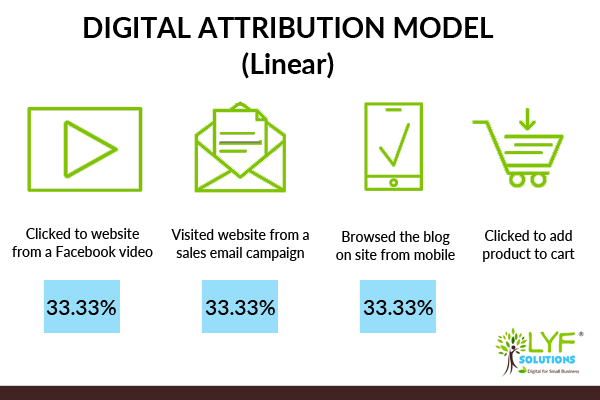
The linear model assigns no channel with 100% of the credit for the conversion. Instead, it evenly distributes the percentage to each channel. So if you have three different touchpoints for a user journey mapped out, each channel would be given 33.33% = 100%.
This model assumes that all the touchpoints happen one after the other and within a timeframe that the tracking cookie (we’ll explore this more in detail later) hasn’t expired over time. It’s best used by a business that wants to understand the diverse range of channels a customer goes through before making a lead or purchase.
Good: You can understand the different channels the user has visited, rather than focus only on the first and last ones. Thus, allows you to get a better glimpse of what a person does before they make a purchase or take action on your website.
Bad: The model assigns the same level of credit to every channel. As business owners, we know that some events may be more meaningful than others. For example, a general awareness email receives the same level of credit to a particular sales offer which could have been the reason behind the customer deciding to make that final purchase.
4. Time decay attribution
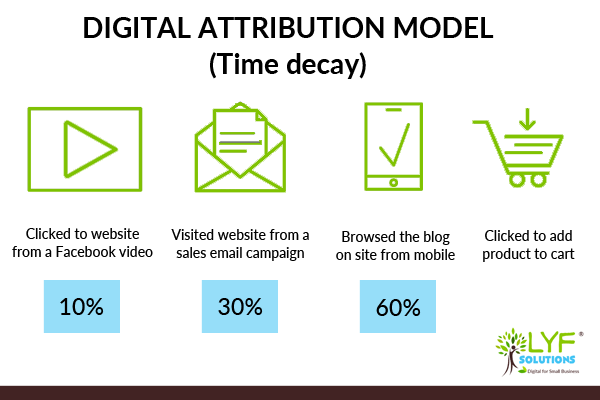
Many customers will likely see several messages before they consider purchasing or expressing interest in a product or service. The time decay attribution model recognises that but also assigns greater credit towards the last channels before action, while not forgetting those previous.
This model works best for a business that has a long path to purchase. It can also be ideal for those that enjoy high traffic but tend to have a low conversion rate.
Good: You can understand the path to purchase more clearly, and give credit to those final channels which drove the customer to act.
Bad: This puts less credit at the start of the love sales funnel. Hence, a highly influential event could have happened at the beginning to trigger the path to act, but this was given less credit for the conversion, so you devalue this activity which may have been the primary driver.
5. Position based attribution

This attribution model is great for those who don’t have a long path to purchase timeframe. It adds 40% of the credit to the first and final touchpoints, then gives 20% of the credit to the middle sections evenly.
Good: It evenly distributes a fair amount of credit to the first and last touchpoints, which means it is not giving an unfair advantage to the start or end paths of the purchase.
Bad: The different events or channels may not be as valuable as they get credited with. For example, would you value a tweet at the start of the funnel as much as you would a brand campaign video later on?
There are of course more than five models. You can see more attribution models here.
Which model of attribution is right for me?
As you can see, there are good and bad sides to any attribution model. For many businesses, there is no one rule to apply. Instead, it can be useful to look at the different models to find out more about your activities and then make a more informed decision when deciding what budget you’d apply to each of your marketing efforts on and offline.
Starting with the position based or time decay model may be of use to you to compare with the default last click attribution model. You can play around with this in Google Analytics.
How do I attribute my activities more effectively?
If you are not adding tracking to your activities, you are not going to be able to attribute sales or actions to the different activities you do. Tracking can be done online and offline.
Online digital attribution tools:
Using Google analytics: Make sure you’ve set up goals or eCommerce tracking as a start. When defining goals, understand which ones will be of use to you most. For instance, a page view goal may be best known for a lead page over an about us section.
Urchin tracking module (UTM) tool: You can use this URL builder to define campaigns and then track them under campaigns in Google Analytics in one spot. This helps to ensure Google correctly defines the channel when the link is clicked, as often emails or other channels may be considered as direct traffic instead. Use this as well for external promotions such as on a bloggers website, so you can attribute and manage what impact that activity had on the sales funnel and the traffic that came via that source more clearly.
Bitly: You can shorten URLs using this tool and then go back and check stats. This is useful for websites that you don’t own but want to know how many times the link was clicked.
Offline digital attribution tools:
- Add a custom URL, phone number or email for offline campaigns like brochures.
- Ask customers where they found out about you.
- Create custom promotional codes based on different marketing materials.
- Categorise your sales by location, salesperson or channel. This method involves good system management and record keeping.
The flaws of attribution in the digital world
In addition to the different attribution models you can use, it’s important to be aware of digital tools and tracking limitations.
Cookies: A cookie is a piece of text that a website stores on a user computer. This text allows the website to understand whether that person has been on the site before. The cookies are used to track the journey but can be deleted or blocked by people. They also can expire depending on their type (usually 90 days by Google for campaign data and two years for users). There are short and long-term cookies based on different events. Unless a person signs in the same way they do on another device, a person will be considered as a new cookie. Therefore, we have no 100% full clear path to purchase.
Google Analytics: Be aware of how digital tracking tools define metrics. For example, users may be the same person if Google is unable to see they are the same individual. Also, sessions are usually measured by 30 minute increments.
Google Signals: In July this year Google announced a new way to track devices. Prior you’d have to set up some advanced codes to do this. This new feature allows Google to track users across different devices who are signed in to Google and who have ads personalisation on (everyone by default has this on). Although this is available and can be turned on here, its focus is on conversions and still in beta mode. Overall, Google has a lot more work to do to make this a viable solution worth analysing in detail.
Mindset: Attribution is a guide, not the answer to your budget questions. It will give you some insight into how people purchase your products, but without further information on your audience and identifying trends in traffic or sales; you are cutting yourself short.
Your digital attribution checklist
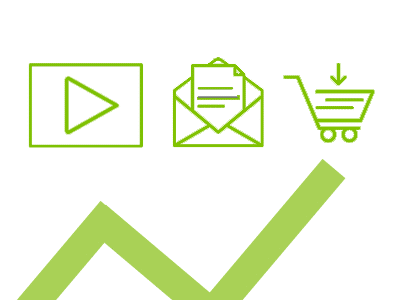
1. Consider the objective
If your campaign objective was to build brand awareness, the first touch model is likely to be more helpful. Instead, if your campaign was about raising consideration, the time decay model may be of more use than the last click model.
2. Compare the different models
Don’t focus on only one attribution model to help you understand your marketing efforts. Play around by using multiple models and learn about the different information you get by doing this.
3. Find out the role each channel plays
Understand the role each channel has in your sales pathway. For example, social media is likely to drive brand awareness overall compared to direct sales. However, this rule doesn’t apply to everyone, so do some analysing of your data and customers first.
4. Focus on the audience, not channel
Look at where you can reach your audience and how effective this is over time. Use multiple avenues to approach them so not to narrow your businesses reliance on one area or channel.
5. Test and learn
When you operate on or offline, business is about experimenting with new things. Be open-minded in your approach and test out new activities, analyse their performance and adjust over time.
Customers have a complex sales pathway and technology isn’t as advanced as people may think, but as time goes on – it’s important to understand what attribution is, its limits and how you can use it to help you with your business goals and objectives.
Note: Google Analytics has been used a lot in this article as it’s most relevant to small business owners given its free option.
Need expert digital marketing help?
We can review your digital marketing efforts and work with you on planning for the future. Contact us to discuss your digital marketing plans and strategy.












